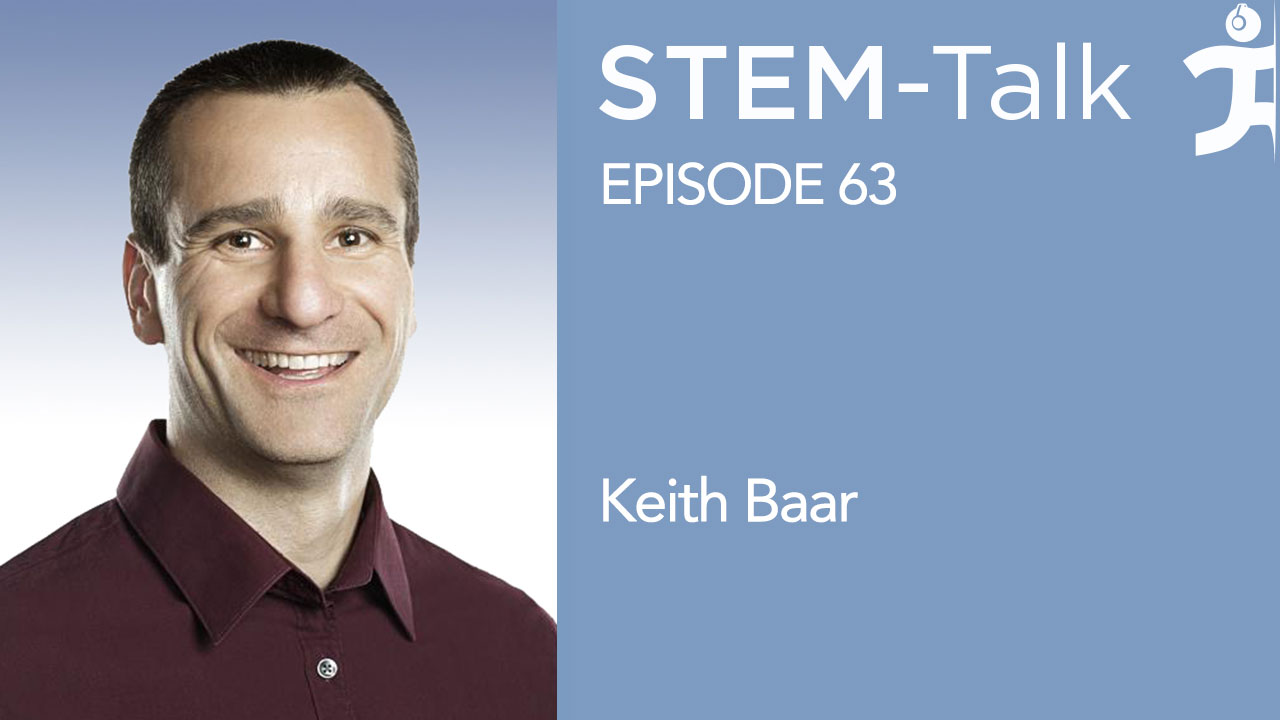STEM-Talk
Episode 63: Keith Baar talks about collagen synthesis, ketogenic diet, mTORC1 signaling, autophagy, post strength training nutrition, and more…
// May 8, 2018

Dr. Keith Baar joins Ken and Dawn today for the second of his two-part interview for STEM-Talk. Keith is a renowned scientist in the emerging field of molecular exercise physiology who has made fundamental discoveries on how muscles grow bigger, stronger, and more fatigue resistant.
He is the head of the Functional Molecular Biology Laboratory in the Department of Neurobiology, Physiology, and Behavior at the University of California, Davis. In his lab, he leads a team of researchers attempting to develop ways to improve muscle, tendon and ligament function.
Part one of our interview, episode 62, covered Keith’s childhood in Canada and his undergrad years at the University of Michigan as well as his time at the University of California, Berkeley, where he earned a master’s degree in human biophysics. We talked about Keith’s work at the University of Illinois, where he received a doctorate in physiology and biophysics. We also covered Keith’s time in the lab of John Holloszy, who is known as the father of exercise research in the United States, as well as the five years Keith spent at the University of Dundee in Scotland.
Episode 63 picks up with Keith explaining his decision to return to the states and join the faculty at the University of California, Davis. Ken and Dawn then talk to Keith about his most recent research, some of which is looking at how to determine the best way to train, as well as what types of foods compliment training to decrease tendon and ligament injury and accelerate return to play. This work has the potential to improve muscle function not only in athletes, but also improve people’s quality of life as they age. Another key topic covered in part two of our interview is the research Keith is doing on a ketogenic diet and its potential to reduce cancer rates and improve cognition. Keith also provides his thoughts on what optimal workouts and nutrition should look like.
Links:
Baar’s UC Davis physiology department bio:
https://www.ucdmc.ucdavis.edu/physiology/faculty/baar.html
Baar’s UC Davis biology department bio:
https://biology.ucdavis.edu/people/keith-baar
Functional Molecular Biology Lab website:
Molecular brakes regulating mTORC1 activation in skeletal muscle paper:
https://www.ncbi.nlm.nih.gov/pmc/articles/PMC4137116/
Age-related Differences in Dystrophin article:
https://www.ncbi.nlm.nih.gov/pubmed/27382038
Show notes:
2:54: Dawn begins part 2 of our interview by mentioning that for the past eight years, Keith has been working at the University of California Davis. She asks Keith what prompted him to return to the U.S. from Scotland and join the faculty at UC Davis.
3:37: Dawn points out that Keith’s Functional Molecular Biology Lab conducts research across a range of related topics, including musculoskeletal development and adaptation as well as methods for engineering functional musculoskeletal tissues in vitro. She asks Keith to give a high-level overview of some of that research.
4:16: Dawn comments that some of Keith’s recent work has shown that we can use specific nutrition and training strategies to optimize injury recovery and prevention. She goes on to say that musculoskeletal injuries are among the most common problems that active people have.
8:45: Ken talks about how Keith has noted that tendon stiffness is dependent upon collagen content, and the amount of crosslinks within. He goes on to mention that Keith has developed various training modalities, as well as nutritional protocols, that can increase and decrease tendon stiffness. Ken begins this line of inquiry by asking about the training methods for this purpose.
12:04: Following up on the previous question, Ken asks whether anyone has looked at how blood flow restriction training, which is increasing in popularity, affects tendon stiffness.
13:32: Dawn moves on to asking about nutrition. She mentions that Keith’s lab has done a great deal of groundbreaking work on the use of gelatin and a small amount of vitamin C to augment collagen synthesis in tendons, ligaments, cartilage, and bone. She asks if he could talk about this nutrition protocol and its effects, particularly when combined with jumping rope.
17:52: Ken mentions that this work is not only interesting scientifically, but it has an immediate, practical application that people can use in their life. Ken goes on to say that those suffering from stress fractures or a variety of other ailments could benefit from this.
21:09: Ken mentions that there are several different forms of collagen, asking if there is any particularly efficacious form, or if they function equally.
22:40: Ken comments that it is not just lower body weakness and injuries in tendons, but also tendonitis that is found in the shoulders and elbows. He asks if there is a variant of Keith’s protocol that is suited for this sort of tendonitis as well.
24:37: Ken asks a question submitted by friends in the special ops community. He mentions that one of their biggest issues is force absorption, due to the repeated, substantial, damage accrued in both training and in operations. He goes on to ask if a focus on eccentric training would lengthen fascicles to allow for greater absorption, and how does it influence the ability to contract concentrically.
26:13: Dawn mentions that she has heard Keith discuss “sugar cross-linking” in the context of aging and diabetes. She asks if this explains why diabetics suffer an increased incidence of tendon and ligament ruptures and injuries.
28:22: Ken, coming back to tendon stiffness, mentions that in addition to fast exercise, inactivity also leads to increased tendon stiffness, counterintuitive as that is. He asks if Keith could discuss this, somewhat surprising, fact.
30:20: Ken comments that ligament engineering is another fascinating area of Keith’s research; he goes on to say that Keith and his colleagues recently engineered the first in vitro ligaments. He goes on to inquire as to how these ligaments are created, what insights can be gleaned from them, and how Keith sees them being used in the future.
34:23: Ken states that mTOR inhibition by rapamycin is arguably the only strategy that has reliably resulted in lifespan extension across a multitude of different species. He goes on to say that we know that mTORC1 activation increases muscle mass and strength, which is critical for optimizing health span into old age. He goes on to bring up a recent paper Keith co-authored with Megan Roberts that showed the ketogenic diet had tissue-specific effects on mTORC1 signaling; decreasing signaling in the liver, while increasing it in the muscle. Ken postulates that perhaps researchers should focus their attention on tissue-specific mTOR activity, to further elucidate the issue of balancing mTOR for longevity with the maintenance of muscle for strength quality. Ken asks Keith if he had unlimited resources, how would Keith design a study to explore this.
43:32: Ken asks if Keith is familiar with a class of drugs that one could characterize as PPAR-delta agonists, sometimes called exercise mimetics, given the overlap between the effects of the ketogenic diet and this class of drugs.
45:10: In regards to longevity, Dawn mentions that few would argue that many elite athletes train for performance at the expense of health. She asks what would be Keith’s overall training recommendation for someone who wants to maximize healthspan and lifespan, and if that is possible while also striving for top levels of performance.
49:24: Ken comments on a belief in the world of “bro science,” that post-exercise carbohydrate ingestion is absolutely necessary for maximizing the anabolic response of resistance training. Ken asks if this is true, and if not, if Keith would educate us as to why and what optimal nutrition and workouts should look like.
51:18: Ken asks what Keith sees as the role of autophagy in the maintenance of muscle mass in aging adults.
53:48: Ken comments on the phenomenon of older people developing anabolic resistance, much like insulin resistance; mentioning a paper that recently looked at the ketogenic diet in that context and found it increased IGF-1 receptor sensitivity.
54:46: Dawn asks to what extent does Keith think a person’s baseline body composition can impact the response to an exercise stimulus.
55:44: Ken points out that Keith has been a scientific advisor for a number of different athletic teams and organizations, pointing out that Keith works to maximize the effects of training for both endurance and strength as well as ways to minimize injury. Ken asks Keith what that experience has been like.
58:27: Ken mentions his intrigue with the mission statement of Keith’s Functional Molecular Biology Lab: “To perform world class musculoskeletal research in a family environment.” Ken asks Keith to explain the story behind including “a family environment” in his mission statement.
1:01:08: Interview ends.






